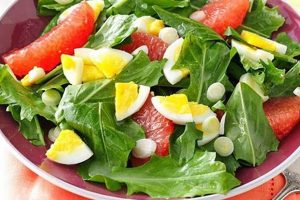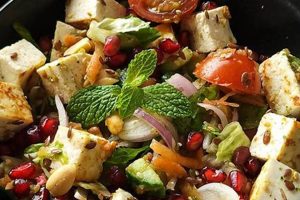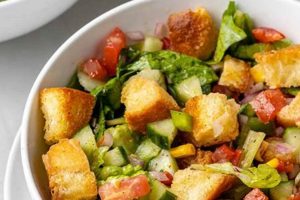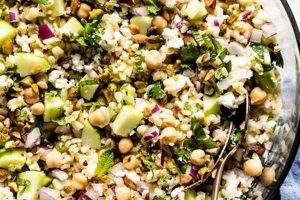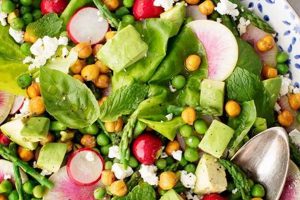Dishes featuring flaked, cooked salmon combined with various chilled ingredients like mayonnaise, vegetables, herbs, and spices constitute a versatile and refreshing category of cuisine. A classic example incorporates cooked salmon, celery, red onion, mayonnaise, and dill, served on bread, crackers, or lettuce cups. Variations can include different herbs, spices, or additions such as capers, hard-boiled eggs, or lemon juice.
These flavorful and nutritious meals offer a convenient and healthy option for lunches, light dinners, or appetizers. Salmon, rich in omega-3 fatty acids and protein, contributes significant health benefits. The flexibility of these dishes allows for adaptation to different dietary needs and preferences, incorporating seasonal ingredients or preferred flavor profiles. Historically, combining cooked fish with other ingredients in chilled preparations has appeared in various culinary traditions for centuries, often as a method of preserving and extending the enjoyment of the catch.
This discussion will explore various aspects of preparing these delectable dishes, covering ingredient selection, preparation techniques, suggested variations, and nutritional information.
Tips for Crafting Exceptional Salmon Salads
Achieving a superior salmon salad requires attention to detail and an understanding of key techniques. The following tips offer guidance for creating dishes that are both flavorful and visually appealing.
Tip 1: Salmon Selection and Preparation: Opt for high-quality, fresh, or sustainably sourced canned salmon. If using fresh salmon, poaching or baking are recommended cooking methods to retain moisture and flavor. Ensure the salmon is cooled completely before flaking to prevent the other ingredients from becoming warm.
Tip 2: Enhancing Flavor Profiles: Fresh herbs such as dill, parsley, and chives contribute brightness. Consider incorporating complementary spices like smoked paprika, cayenne pepper, or Old Bay seasoning. A touch of lemon zest or juice adds a citrusy note.
Tip 3: Balancing Texture and Creaminess: Finely diced celery, red onion, or bell peppers provide satisfying texture. Mayonnaise is the traditional binder, but Greek yogurt or a combination of the two offers a lighter alternative. Capers or chopped cornichons introduce a briny element.
Tip 4: Creative Ingredient Combinations: Explore diverse flavor combinations by adding ingredients such as chopped apples, grapes, or dried cranberries for sweetness and textural contrast. Avocado adds creaminess and healthy fats. Hard-boiled eggs contribute protein and richness.
Tip 5: Proper Chilling and Serving: Allow the salad to chill thoroughly in the refrigerator for at least 30 minutes to allow the flavors to meld. Serve chilled on bread, crackers, lettuce cups, or as a filling for wraps or sandwiches.
Tip 6: Mindful Ingredient Proportions: Avoid overwhelming the delicate flavor of the salmon with excessive mayonnaise or other ingredients. Strive for a balance that allows the salmon to shine while complementing it with other flavors and textures.
Tip 7: Presentation Matters: A visually appealing presentation enhances the dining experience. Garnish the salad with fresh herbs, a sprinkle of paprika, or a wedge of lemon. Consider using attractive serving dishes and arranging the salad thoughtfully.
By following these tips, one can elevate salmon salad from a simple dish to a culinary creation that is both satisfying and memorable. These guidelines offer a starting point for experimentation and customization, allowing for endless variations.
The following section will offer specific recipe examples illustrating these principles.
1. High-quality Salmon
The foundation of exceptional cold salmon salad rests upon the quality of its primary ingredient: salmon. Selecting superior salmon significantly impacts the final dish’s flavor, texture, and overall appeal. This section explores the crucial aspects of high-quality salmon and its implications for creating remarkable cold salmon salads.
- Sourcing and Sustainability:
Responsibly sourced salmon, whether wild-caught or farmed using sustainable practices, contributes to both environmental well-being and superior flavor. Wild-caught salmon often exhibits a more robust, complex flavor profile, influenced by its natural diet and habitat. Sustainably farmed salmon offers a consistent flavor and texture while minimizing environmental impact. Choosing salmon with certifications like the Marine Stewardship Council (MSC) label ensures responsible sourcing.
- Freshness Indicators:
Fresh salmon possesses a bright, translucent flesh with a firm texture and a mild, fresh aroma. Avoid salmon with dull, opaque flesh, a strong fishy odor, or any signs of discoloration. For fresh salmon, proper storage at low temperatures is essential to maintain quality. If using canned salmon, opt for varieties packed in water or olive oil, avoiding those with added salt or flavorings that can mask the natural salmon flavor.
- Species Selection:
Different salmon species offer unique flavor profiles and textures. King salmon, known for its rich, buttery flavor and large flakes, is a premium choice. Sockeye salmon boasts a deep red color and a firm texture with a pronounced flavor. Coho salmon offers a milder flavor and a delicate texture. The chosen species influences the overall character of the salad.
- Impact on the Final Dish:
High-quality salmon elevates the cold salmon salad experience. The inherent flavor and texture of the salmon directly translate to the finished dish. A superior starting ingredient requires less manipulation with seasonings and additions, allowing the natural salmon flavor to shine through. The texture of the salmon flakes also contributes to the overall mouthfeel and enjoyment of the salad.
Utilizing high-quality salmon ensures a cold salmon salad that is not only delicious but also reflects a commitment to both culinary excellence and responsible consumption. The choice of salmon establishes the baseline for flavor and texture, influencing the success of the final dish. Careful consideration of sourcing, freshness, and species selection are paramount in achieving a superior culinary outcome.
2. Flavorful Additions
Flavorful additions play a crucial role in transforming cold salmon salad from a simple dish into a culinary delight. These additions enhance the inherent flavor of the salmon while contributing complexity and depth. The careful selection and balance of these components significantly impact the overall sensory experience. Several categories of flavorful additions contribute distinct characteristics to cold salmon salads:
Aromatics: Aromatics like finely diced red onion, shallots, or chives impart a pungent sharpness that cuts through the richness of the salmon and mayonnaise. These ingredients add a refreshing layer of flavor and contribute to a balanced flavor profile. For instance, the subtle bite of red onion complements the delicate flavor of salmon, while chives offer a mild onion flavor with a hint of garlic. These aromatics contribute not only to the taste but also to the overall aroma of the salad.
Herbs: Fresh herbs are essential for elevating cold salmon salads. Dill, parsley, and chives are classic choices, providing brightness and freshness. Dill, with its slightly anise-like flavor, pairs particularly well with salmon. Parsley adds a clean, herbaceous note, while chives offer a delicate onion flavor. Other herbs like tarragon or chervil can also be incorporated for unique flavor profiles. The use of fresh herbs significantly enhances the overall sensory experience.
Spices: Spices introduce warmth and complexity. A pinch of smoked paprika adds a smoky depth, while cayenne pepper provides a touch of heat. Old Bay seasoning, with its blend of herbs and spices, contributes a savory dimension. The judicious use of spices can elevate the flavor profile without overpowering the delicate taste of the salmon.
Acidic Elements: Acidic components like lemon juice, vinegar, or capers provide brightness and balance the richness of the salmon and mayonnaise. A squeeze of lemon juice adds a refreshing citrusy note, while a splash of white wine vinegar introduces a subtle tang. Capers, with their briny flavor, contribute a salty and piquant element. These acidic additions enhance the overall flavor profile and prevent the salad from feeling too heavy.
The interplay of these flavorful additions creates a symphony of tastes and textures that elevate cold salmon salad to a new level. The careful balance of aromatics, herbs, spices, and acidic elements ensures a harmonious and delicious final product. Understanding the role of each component allows for customized flavor profiles tailored to individual preferences.
3. Textural Balance
Textural balance is a crucial aspect of crafting appealing cold salmon salad recipes. A successful salad engages multiple senses, not just taste. A harmonious interplay of textures elevates the dining experience, preventing monotony and enhancing enjoyment. Consider the contrast between the flaky tenderness of salmon and the crisp snap of celery; this interplay offers a more dynamic and satisfying mouthfeel than a uniformly smooth or mushy salad. The presence of contrasting textures encourages more mindful consumption, as each bite presents a slightly different sensory experience. This textural diversity adds complexity and interest, transforming a simple combination of ingredients into a culinary creation.
Several ingredients contribute to textural balance. Finely diced vegetables like celery, red onion, and bell peppers introduce crispness. Chopped nuts, such as walnuts or pecans, add a satisfying crunch. The inclusion of ingredients like capers or chopped cornichons offers a burst of briny, slightly acidic flavor alongside a textural variation. Even the choice of bread or crackers for serving impacts the overall textural profile; a crusty baguette provides a stark contrast to the softness of the salad, while delicate crackers offer a subtle crunch. The goal is to achieve a harmonious blend of textures that complement the inherent qualities of the salmon and other ingredients.
Achieving textural balance requires mindful ingredient selection and preparation. Vegetables should be diced to a size that offers noticeable texture without overwhelming the salmon. If incorporating nuts, consider toasting them lightly to enhance their crunch. The proportion of textural elements should be carefully considered; too much crunch can be distracting, while too little can result in a bland experience. A well-balanced cold salmon salad provides a delightful interplay of textures that elevates the dish beyond a simple combination of flavors, showcasing the importance of textural complexity in culinary arts. This attention to detail transforms a basic salad into a multi-sensory experience.
4. Proper Chilling
Proper chilling is essential for both food safety and optimal flavor development in cold salmon salad recipes. Chilling allows the flavors of the various ingredients to meld and harmonize, creating a more cohesive and complex flavor profile. Moreover, maintaining safe temperatures inhibits bacterial growth, ensuring the dish remains safe for consumption.
- Food Safety:
Chilling the prepared salmon salad promptly and maintaining it at a safe temperature below 40F (4C) is paramount for preventing bacterial growth. This practice significantly reduces the risk of foodborne illnesses. Leaving the salad at room temperature for extended periods creates an environment conducive to bacterial proliferation, potentially leading to health hazards.
- Flavor Development:
Chilling allows the diverse flavors of the ingredientssalmon, vegetables, herbs, and dressingsto meld and harmonize. The flavors become more integrated and balanced during chilling, creating a more nuanced and enjoyable culinary experience. The low temperature slows down chemical reactions, preventing flavors from becoming muddled or overly pronounced.
- Texture Enhancement:
Chilling firms the texture of the salmon and other ingredients, improving the overall mouthfeel of the salad. This firming effect enhances the textural contrast between ingredients, creating a more satisfying sensory experience. A chilled salad holds its shape better when served, contributing to a more visually appealing presentation.
- Best Practices:
Best practices for chilling include refrigerating the salad in a shallow container to facilitate rapid and even cooling. Covering the container prevents the salad from drying out or absorbing odors from other foods in the refrigerator. Allowing the salad to chill for at least 30 minutes, or preferably longer, ensures optimal flavor development and food safety.
Proper chilling is integral to both the safety and enjoyment of cold salmon salad. By adhering to safe chilling practices and allowing adequate time for flavor development, one ensures a dish that is both delicious and safe to consume. The attention to temperature control reflects a commitment to culinary excellence and food safety best practices.
5. Creative Variations
Creative variations within cold salmon salad recipes offer opportunities to explore diverse flavor profiles and cater to individual preferences. These variations extend beyond the classic preparations, incorporating a wide range of ingredients and culinary influences. The adaptability of cold salmon salad allows for experimentation with global flavors, seasonal ingredients, and dietary restrictions. This versatility transforms a traditional dish into a platform for culinary innovation.
One can achieve creative variations through ingredient substitution and additions. Substituting Greek yogurt for mayonnaise offers a lighter, tangier alternative, while incorporating ingredients like chopped apples, grapes, or dried cranberries introduces sweetness and textural complexity. Avocado adds creaminess and healthy fats, while the inclusion of different herbs and spices, such as cilantro, mint, or curry powder, introduces ethnic flavors. These variations not only enhance the nutritional value but also elevate the culinary experience, showcasing the adaptability of the basic recipe. For example, a Mediterranean-inspired variation might include Kalamata olives, feta cheese, and oregano, while an Asian-inspired version could incorporate soy sauce, ginger, and sesame seeds. Such variations demonstrate the potential of cold salmon salad to transcend traditional boundaries.
The practical significance of exploring creative variations lies in the ability to personalize dishes and cater to a broader range of palates. These variations offer opportunities to utilize seasonal ingredients, minimizing reliance on out-of-season produce and maximizing freshness and flavor. Furthermore, creative variations accommodate dietary restrictions and preferences, allowing for the creation of gluten-free, dairy-free, or vegetarian versions. The adaptability of cold salmon salad empowers individuals to create dishes that align with their specific needs and culinary desires, promoting both culinary exploration and healthy eating habits. This versatility ensures the continued relevance and appeal of cold salmon salad within a diverse culinary landscape.
6. Presentation
Presentation plays a significant role in the overall enjoyment of cold salmon salad. While flavor and texture are paramount, visual appeal enhances the dining experience, stimulating appetite and creating a sense of anticipation. Thoughtful presentation elevates the perceived value of the dish, transforming a simple meal into a more refined culinary offering. The following facets highlight key considerations for presenting cold salmon salad effectively.
- Plating:
The choice of serving vessel significantly impacts the presentation. A simple yet elegant plate allows the salad to take center stage. Alternatively, serving the salad in a scooped-out avocado half or within crisp lettuce cups adds visual interest and textural contrast. For larger gatherings, a beautifully arranged platter creates a focal point. The plating should complement the salad’s colors and textures, enhancing its visual appeal.
- Garnishing:
Garnishes provide finishing touches that enhance the visual appeal and often contribute subtle flavor nuances. Fresh dill sprigs, a sprinkle of paprika, lemon wedges, or a scattering of capers elevate the presentation and complement the flavors of the salad. Garnishes should be chosen thoughtfully, considering both their visual and gustatory contributions. Over-garnishing can detract from the main dish, so a balanced approach is crucial.
- Color and Contrast:
The inherent colors of the salad componentsthe pink salmon, vibrant green herbs, and creamy white dressingprovide a natural starting point for an appealing presentation. Enhancements, such as incorporating colorful vegetables like bell peppers or red onion, further amplify visual appeal. Creating contrast between colors and textures adds depth and visual interest, making the salad more enticing.
- Context and Occasion:
The presentation should align with the context of the meal. A casual lunch might call for a simple presentation on a bed of lettuce or in a sandwich, while a more formal dinner might warrant a more elaborate plating with carefully chosen garnishes. The occasion influences the level of formality and the overall presentation style. Adapting the presentation to the context ensures a harmonious dining experience.
By considering these facets of presentation, one elevates cold salmon salad from a simple dish to a more refined culinary experience. Thoughtful presentation enhances enjoyment, demonstrating attention to detail and a commitment to culinary excellence. These considerations transform a basic salad into a visually appealing and appetizing culinary creation, emphasizing that presentation is an integral part of the overall dining experience.
7. Nutritional Value
Nutritional value represents a significant aspect of cold salmon salad recipes. Salmon, a rich source of omega-3 fatty acids, protein, and essential vitamins and minerals, forms the nutritional cornerstone of these dishes. Omega-3 fatty acids contribute to cardiovascular health and cognitive function. Protein supports muscle growth and repair. The inherent nutritional benefits of salmon make these salads a healthy and satisfying meal option. Furthermore, the inclusion of fresh vegetables, such as celery, onions, and bell peppers, adds dietary fiber, vitamins, and antioxidants, enhancing the overall nutritional profile. For example, a salad incorporating wild-caught salmon, mixed greens, and a variety of colorful vegetables provides a nutrient-dense meal rich in omega-3s, fiber, and essential micronutrients. The specific nutritional content varies depending on the chosen ingredients and preparation methods.
Understanding the nutritional composition of cold salmon salad allows for informed dietary choices. Individuals seeking to increase their omega-3 intake or maintain a healthy protein intake can benefit from incorporating these salads into their meal plans. Adjustments to ingredients and portion sizes can further tailor the nutritional content to meet specific dietary needs. Opting for low-fat mayonnaise or yogurt-based dressings reduces overall fat and calorie content. Incorporating whole-grain bread or crackers for serving adds dietary fiber. These modifications demonstrate the adaptability of cold salmon salad to various dietary goals. Careful consideration of ingredient choices and preparation techniques empowers individuals to maximize the nutritional benefits of these versatile dishes.
The nutritional value of cold salmon salad recipes underscores their importance as part of a balanced and healthy diet. These dishes offer a convenient and flavorful way to incorporate essential nutrients, particularly omega-3 fatty acids and protein. By understanding the nutritional composition and making informed choices regarding ingredients and preparation methods, individuals can maximize the health benefits while enjoying a delicious and satisfying meal. This awareness promotes healthy eating habits and empowers individuals to make informed dietary choices.
Frequently Asked Questions
This section addresses common inquiries regarding cold salmon salad recipes, providing concise and informative responses.
Question 1: What type of salmon is best suited for cold salmon salad?
Canned salmon, particularly wild-caught varieties packed in water or olive oil, offers convenience and consistent quality. Fresh, cooked salmon also works well, provided it is properly chilled before flaking.
Question 2: How long can cold salmon salad be stored in the refrigerator?
Properly stored in an airtight container, cold salmon salad typically remains safe for consumption for up to three to four days in the refrigerator. However, consuming it within two days is recommended for optimal flavor and quality.
Question 3: Can cold salmon salad be frozen?
Freezing is generally not recommended, as it can negatively impact the texture and flavor of the salad. The mayonnaise-based dressing can separate upon thawing, resulting in a less desirable consistency.
Question 4: How can one reduce the fat content in cold salmon salad?
Substituting Greek yogurt for mayonnaise, either partially or entirely, effectively reduces fat content without significantly compromising flavor or creaminess. Additionally, using salmon packed in water rather than oil contributes to a lower overall fat content.
Question 5: What are some gluten-free options for serving cold salmon salad?
Gluten-free crackers, lettuce cups, or cucumber slices offer suitable alternatives to bread or traditional crackers. The salad can also be served as a dip with gluten-free vegetable sticks or chips.
Question 6: How can one adapt cold salmon salad recipes for different dietary needs?
Adapting recipes to dietary requirements involves ingredient substitutions and mindful preparation techniques. For dairy-free versions, avoid mayonnaise and opt for plant-based alternatives. Vegetarian adaptations can utilize ingredients like chickpeas or lentils to mimic the texture and protein content of salmon. Ingredient labels should be carefully examined to ensure compliance with specific dietary restrictions.
Understanding these frequently asked questions empowers individuals to confidently prepare and enjoy cold salmon salad while addressing potential concerns regarding ingredient selection, storage, and dietary adaptations. These insights contribute to a more informed and satisfying culinary experience.
The following section will explore various serving suggestions and accompaniments for cold salmon salad.
Conclusion
Exploration of cold salmon salad recipes reveals a versatile culinary landscape encompassing ingredient selection, preparation techniques, flavor variations, presentation, and nutritional considerations. Emphasis on high-quality salmon, balanced flavor profiles, appropriate textural elements, and safe chilling practices underscores the potential for culinary excellence. Creative adaptations accommodate diverse dietary preferences and expand culinary horizons.
Culinary enthusiasts are encouraged to explore the multifaceted world of cold salmon salad recipes, experimenting with flavors and textures to create personalized culinary experiences. The adaptability of these recipes ensures their continued relevance in a dynamic culinary environment. Further exploration may delve into regional variations, sustainable sourcing practices, and innovative flavor combinations, fostering a deeper appreciation for this versatile dish.

